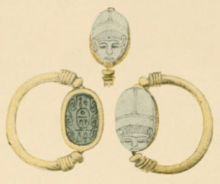Percy Newberry
Percy Edward Newberry (23 April 1869 – 7 August 1949) was a British Egyptologist.
Biography
_(14581836299).jpg)
Percy Newberry was born in Islington, London on 23 April 1869. His mother was named Caroline Wyatt, and his father, Henry James Newberry, was a woollen warehouseman. Newberry developed a strong attachment to botany in childhood and was also an excellent artist. He studied first at King's College School and later at King's College London. In 1884, on the invitation of Reginald Stuart Poole, Newberry began administrative work at the Egypt Exploration Fund, founded just two years previously. He continued in this role until 1886, and afterwards began his own research in Egyptology.
In 1891 Newberry travelled to Egypt with Howard Carter, whom Newberry had appointed as a trainee tracer, after recognising his talent as an artist. There they worked on the excavation of Beni Hasan and El-Bersheh, which Newberry led from 1890 to 1894. Newberry later served on the Tutankhamun excavation team for several seasons. His speciality was the botanical specimens from the tomb, on which he would briefly report in the second volume of Carter's The Tomb of Tut.ankh.Amen.
Newberry was the first Brunner Professor of Egyptology at the University of Liverpool, serving in the chair from 1906 to 1919. He was then an honorary Reader in Egyptian Art (1919 to 1949). He was also a fellow of King's College, London, (1908 to 1949), and Professor of Ancient History and Archaeology at Cairo University (1929 and 1933).
Works

- Beni Hasan. London: Kegan Paul, Trench, Trübner & Co. 1893.
- El Bersheh. Archaeological survey of Egypt, 3rd memoir. London: Egypt Exploration Fund. 1895.
- The life of Rekhmara. Westminster: Archibald Constable. 1900.
- A short history of ancient Egypt. London: Archibald Constable. 1904. (with John Garstang)
- Scarabs: an introduction to the study of Egyptian seals and signet rings. London: Archibald Constable. 1906.[1]
- Scarab-shaped seals. Catalogue général des antiquités égyptiennes du Musée du Caire, v. 32. London: A. Constable and Co. 1907.
- The Timins collection of ancient Egyptian scarabs and cylinder seals. London: Archibald Constable. 1907.
- Egypt as a field for anthropological research. Washington. 1925.
- Funerary statuettes and model sarcophagi. Catalogue général des antiquités égyptiennes du Musée du Caire. Cairo (Le Caire): Institut français d'archéologie orientale. 1930.
References
- "Review of "Scarabs. An Introduction to the Study of Egyptian Seals and Signet Rings." by Percy E. Newberry". Journal of the Royal Asiatic Society of Great Britain and Ireland: 511–513. April 1906.
External links
- "Percy Newberry, Egyptologist, Dies". The New York Times. 1949-08-08. Retrieved 2009-02-28.
- Fagan, Brian. "Newberry, Percy Edward". Oxford Dictionary of National Biography. Oxford University Press.
- "Faculty of Asian & Middle Eastern Studies: Percy Edward Newberrry (1868-1949), Egyptologist". University of Cambridge. Archived from the original on 2014-07-07. Retrieved 2014-05-11.